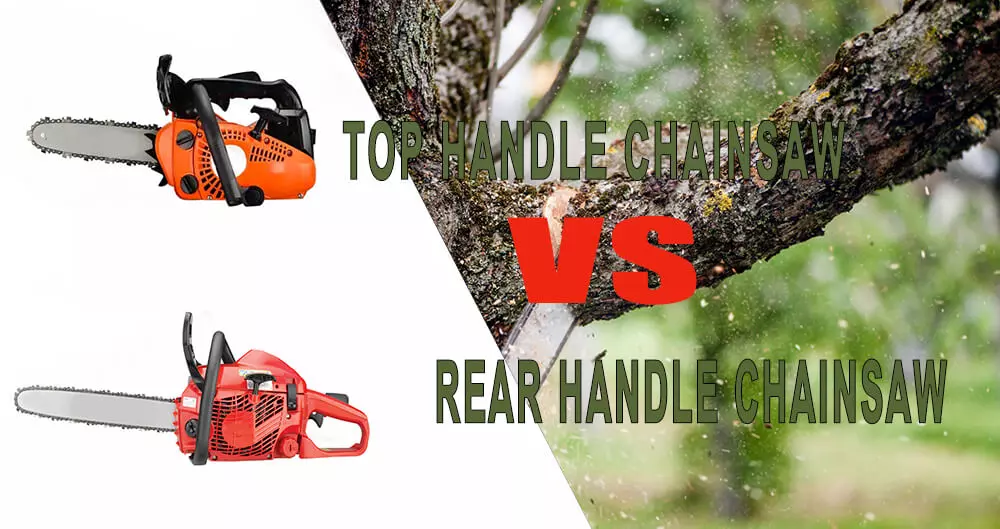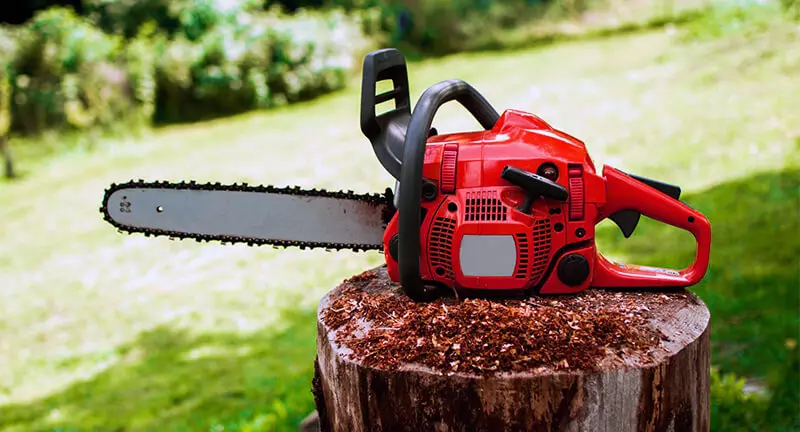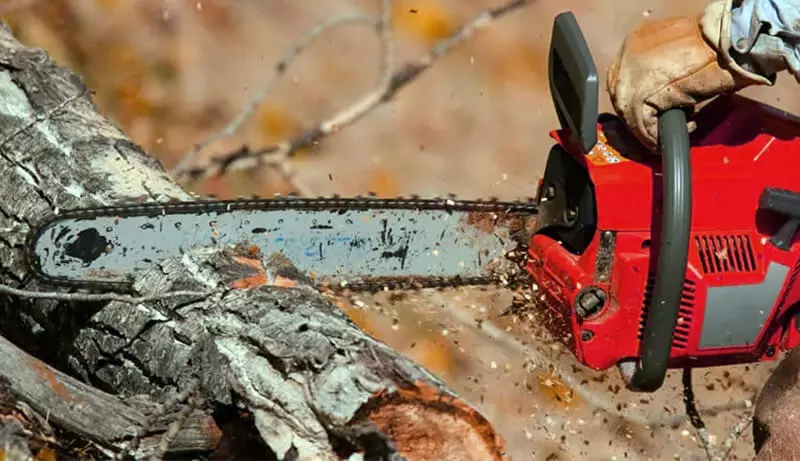03Jan 2024
table of contents

Chainsaws can transform dense forests into finely cut wood materials with a mere pull of a trigger. Offering sharpness, speed, and strength in one compact design, effectively facilitating the cutting task.
There exists an extensive variety of chainsaws in the market, each specifically designed to cater to the diverse needs and preferences of various user groups. Among them, top handle chainsaws and rear handle chainsaws are two different categories. These two chainsaws not only have different appearances, but also have different functional features, which often trigger debates among users. BISON works with you to explore and compare top and rear handle chainsaws, dissecting their respective designs and operations, delving into applications and their suitability for various situations, and pricing to guide you through your decision step by step.
Top Handle Chainsaw
At first encounter, a top-handle chainsaw might not seem strikingly unusual from any other chainsaw on the block: it displays an array of formidable teeth securing a robust bar, all of which are powered by a potent motor. However, a closer inspection reveals distinguished subtleties within its design. You'll notice that all vital components - the motor, the handle, and the cutting bar - are strategically positioned at the top of the device.
Hidden within this seemingly austere direction is a design masterpiece that offers some definite advantages:
Compact: One of the main advantages of a top handle chain saw is its compact shape. This design allows users to operate in close quarters where space is limited. When working in congested areas or making precise cuts, compactness becomes critical to ensure that the chainsaw can fit comfortably into a blind person's work scenario.
Light weight: Top handle chainsaws, despite their power, are generally lightweight. This makes them ideal for long-term use where fatigue needs to be minimized. Additionally, the weight balance provides the user with much-needed flexibility to operate the saw with just one hand, an advantage that is critical in a variety of work environments.
Controllability: The compact structure and weight advantages naturally bring superior controllability. This becomes especially important when navigating tight spaces or climbing trees.
Durability: Top handle chainsaws are designed to withstand severe impacts during operation.
Easy to store: Its smaller footprint also means easier storage. This is especially useful when storage space is limited.
Potential disadvantages:
Power limitations: While top handle chainsaws are great for complex cuts and maneuvers in tight spaces, they may lack the sheer cutting power of rear handle chainsaws. This makes them less efficient when handling larger, denser logs or trees.
Professional use: Due to their unique one-handed operation, top handle chainsaws typically require a higher level of skill and experience to operate safely and effectively, and are often favored by professionals who are able to skillfully use them to their advantage.
Maintenance requirements: Due to its compact size, maintenance activities such as chain replacement or timely inspections may be more challenging compared to rear handle models.

Rear Handle Chainsaw
Rear handle chainsaws have the engine mounted at the back and have separate handles for throttle and joystick control, creating a different type of user experience. Let's dive into the advantages this design brings:
Convenience: Easy-to-operate saw controls are a hallmark of rear-handle saw designs. Throttle and joystick controls with dedicated grips allow for faster, more streamlined operation, a boon for completing intensive tasks under tight deadlines.
More power: Rear-handle chainsaws are generally more powerful and can cut through thick logs and dense trees.
Excellent handling: Weight is distributed rearward and the independent handle improves control and balance, especially during horizontal cutting tasks.
Perfect for novices: Simplified operation paired with stable handling makes the rear handle chainsaw a desirable choice, especially for beginners dipping their toes into chainsaw operation. Its intuitive design simplifies the learning curve and helps novices gain a firm grip on chainsaw operation.
Nonetheless, the design of rear handle chainsaw does come with its own potential disadvantages:
Use of both hands: Unlike top handle chainsaws which offer the elasticity for single handed use, the operation of rear-handle chainsaws entails the involvement of both hands. This can be a limitation in situations, when the use case demands one hand to be available for other tasks such as steadying the object being cut or maintaining balance.
Size and weight: Generally speaking, rear-handle chainsaws, do tend to be bulkier and heftier compared to their top-handle cousins, frequent and prolonged use can cause user fatigue. Additionally, their greater dimensions and weight can result in decreased portability, and more difficult to store.
Limited maneuverability: Due to its size and weight, rear handle chainsaws don’t perform well in tight spaces. They can also be challenging to maneuver when extensive work at height is required.
Additionally, there are some potential disadvantages worth highlighting:
High noise levels: Owing to their substantial power output, rear handle chainsaws often generate significant noise during operation, which can cause inconvenience in residential areas.
Increased fuel consumption: The typically larger engines of rear-handle chainsaws often burn through fuel more rapidly. This rise in fuel usage directly resulting in increased operating costs.
Potential safety hazards: The superior power output and weightier design of a rear-handle chainsaw could potentially create safety risks if not carefully managed, especially for inexperienced users.
How people use chainsaws depends largely on tuser's specific needs and their tasks. Now that we have a solid understanding of the distinct designs and handling methods for both top handle and rear handle chainsaws, let's delve into the details of their applications and suitability for certain tasks.
Top handle chainsaw
Top handle chainsaws are compact and lightweight, making them better suited for:
Arborists and tree care professionals: Due to its compact size and one-handed operation capabilities, the top handle chain saw is ideal for tree care professionals who frequently need to climb trees for pruning and pruning tasks.
Occasional home use: Homeowners who perform occasional firewood cutting or lighter landscaping tasks will also find top-handle chainsaws convenient due to their portability and ease of use.
However, it is not suitable for:
Felling Llarge trees: The power limitations of top handle chainsaws make them less suitable for felling large trees, and using a more powerful chain saw type can usually accomplish the task better.
Basic work or long-term use: Although top-handle chain saws are convenient and flexible, they are not designed for intensive basic work or long-term use, mainly because of their smaller engines and fuel tanks.
Next let's take a look at the rear handle chainsaw.
Rear handle chainsaw
The powerful and stable nature of rear handle chainsaws makes them the first choice for heavy-duty tasks, making them ideal for:
Professional lumberers and heavy duty cutting: The added power and versatility of rear-handle chainsaws make them popular among professionals involved in logging, tree felling, and other heavy-duty cutting tasks.
Homeowners with larger properties: Those who own larger properties and require frequent firewood will often find that rear-handle chainsaws have more power and cutting capabilities.
However, their disadvantages may make them less suitable for certain situations:
Working in tight spaces: The larger design and lower mobility of rear handle chainsaws limits their ability to perform precise work in tight spaces.
One-handed operation: Their weight and size require two hands to operate, making them less suitable for tasks where one hand should ideally be free.
After understanding the design operation and suitability of top and rear handle chainsaws, it is now time to delve into the pricing range of these chainsaws.

Top handle chainsaw
top handle chainsaws represent professionalism and unique design advantages, and they tend to be expensive. Compared to rear handle chainsaws, they tend to cost around 15-30% more, depending on their respective size, make, and model. Price depends largely on factors such as engine power, rod length, and more. However, the extra cost means these chainsaws offer greater maneuverability and rugged durability for treetop tasks, especially for professionals in the tree care industry.
Rear handle chainsaw
In contrast, rear handle chainsaws are generally cheaper than top handle chainsaws, and the relatively low price does not affect their functionality, making them an economical choice for heavy cutting tasks.
Worth noting that while the initial purchase price is certainly a factor in your decision, there are other costs to owning a chainsaw. These may include maintenance, fuel or electricity, oil, chain replacement and safety equipment.
Every chainsaw has its role and unique benefits. Top handle chainsaws are compact and lightweight, primarily designed to meet the needs of professional arborists and those who need to complete tasks in tight spaces or at high altitudes. They are very maneuverable but also more expensive. Rear handle chainsaws, on the other hand, excel in heavy-duty applications such as logging and felling larger trees. This is a highly recommended tool for homeowners maintaining larger properties. Despite their bulkier size and reduced maneuverability, more lower price makes them a very cost-effective option.
Regardless of type of chainsaw you deem most suitable for your needs, it would always be a prudent decision to conduct comprehensive research and refer to product reviews, to ensure your chainsaw will be a long-term investment, not just a short-term tool.
In case you are still uncertain about which chainsaw type would ideally cater to your requirements, or need more personalized counsel, don't forget that the BISON team is here for your assistance. We are steadfast in our dedication to guide you through these intricate decisions, facilitating your investment in a chainsaw that will efficiently accomplish your tasks whilst ensuring a safe and comfortable user experience.
inquiry form here
BISON BLOG, All the latest news and views from Bison Machinery.